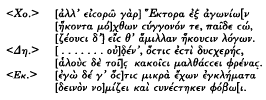Article contents
Notes on fragments of Euripides1
Published online by Cambridge University Press: 11 February 2009
Extract
This is Snell's text:

- Type
- Research Article
- Information
- Copyright
- Copyright © The Classical Association 1997
References
2 ZPE24(1977)291–2 = Euripidea (Oxford, 1994) 171–2.
3 Hellenika 29 (1976) 340–3.
4 Lustrum 9 (1964) 70
5 APF7 (1924) 256.
6 BICS Suppl.32(1974)45.
7 Loc. cit. (above, n. 6) 57, n. 12.
8 See Gnomon 47 (1975) 289–90 = Euripidea 145–6.
9 Scenes from Greek Drama (Berkeley and Los Angeles, 1964) 83.
10 10 On locative datives in general see KG 1.441–3.
11 Reported by Blaydes, Adversaria in Tragicorum Graecorum Fragmenta Halle, 1894) 101.
12 Op. cit. (above, n. 11)312.
13 Not (Nauck, Kambitsis), since the singular must be understood as subject of Uxvei (so Wecklein, BPhW34 [1914] 1059, Philologus 79 [1923–1] 56, n. 4). Variation between plural and singular is regular only in the case of personal subjects (KG 1.56–7, 87), such as at Su. 435–6, adduced (in support of yvw^aic) by Kambitsis.
14 (Wecklein) is needless: see Housman, Classical Papers 769.
15 Euripidean Fragments emended (London, 1920)8–9.Google Scholar
16 Exercitationes criticae (The Hague, 1862) 35.Google Scholar
17 REG 80 (1967) 148–51.Google Scholar
18 See Pearson, A. C., CQ 13 (1919) 119–20, endorsed by H. Lloyd-Jones and N. G. Wilson, Sophoclea (Oxford, 1990) 91CrossRefGoogle Scholar
19 Austin, C., Noua Fragmenta Ewipidea in Papyris reperta (Berlin, 1968), A. Martinez Diez, Euripides, Erecteo (Granada, 1976), P. Carrara, Euripide, Eretteo (Papyrologica Florentina III, Florence, 1977). See also the edition by M. J. Cropp in C. Collard, M. J. Cropp and K. H. Lee, Euripides, Selected Fragmentary Plays, vol. i (Warminster, 1995).Google Scholar
20 DLZ 2 (1881) 161, anticipating Wecklein (SBAM1890, i, 42) and Blaydes, op. cit. (above, n. 11)125.
21 Loc. cit. (above, n. 20).
22 Zeitschr.f.d. Alterthumsw. 1839, 1127, anticipating Meineke (ibid., 1844,14).
23 Op. cit. (above, n. 11)321.
24 QUCC1 (1979) 134–6.
25 Sileno 1 (1975) 70.
26 In his edition of Lycurg., Leocr. (Cambridge, 1743).
27 Loc. cit. (above, n. 25) 71.
28 Lycurge, Contre Leocrate (Bude ed., 1932).
29 Licurgo, Orazione contro Leocrate (Rome, 1966).
30 Euripides, Samtliche Tragodien und Fragmente 6 (Munich, 1981).
31 Lycurgus, The Speech against Leocrates (Cambridge, 1922).
32 Minor Attic Orators (Loeb ed., 1954).
33 Kleine Schriften 1 (Gottingen, 1953) 1–104 (on viv see 9–10). For further literature on Wackernagel′s law see my The Textual Tradition of Euripides′ Orestes (Oxford, 1991) 59, and Euripidea 170.
34 See Fraenkel, E., Kleine Beitrdge 1 (Rome, 1964) 101–2.Google Scholar
35 For TTOXIV. aXXrjv. (without ro1) cf. Hi. 292 aAAov. StAriai Xoyov.
36 The relevant material may be found in C. De Heer, MAKAP-EYAAIMQNOABIOZ EYTYXHE (Amsterdam, 1969), M. McDonald, Terms for Happiness in Euripides (Gottingen, 1978).
37 See Papyrologica Florentina 7 (1980) 58. To the literature cited there add KG 1.660, D. J. Mastronarde on Ph. 497–8.
38 Mnem.23(1970)121.
39 See Collard on the former passage, Mastronarde on the latter.
40 For the aspiration (ofxoc) see Pfeiffer on Call. fr. 1.27, M. L. West on Hes. Op. 290
41 The text is cited by Austin 22, Carrara 38. In passing I suggest that the first sentence of another testimonium, Hyginus 46 (Austin 23, Carrara 40), would be the better for a small addition: 'Erectheus Pandionis filius habuit filias quattuor, quae inter se coniurarunt si una earum [eorum, by a slip of the pen, Austin and Carrara] mortem obisset ceterae se interficerent'. Cf. Hygin. 2 'iniit consilium cum totius generis matronis et coniurauit ut fruges in sementem quas daret torrerent', and TLLIV339–41.
42 See Textual Tradition (above, n. 33) 138, n. 18; Euripidea 475, n. 158.
43 See L. P. E. Parker, CQ 18 (1968) 266.
44 For the text of this passage see Euripidea 364–70.
45 45 See Kannicht ad loc.
46 For comparable formulations with verbs, see ![]()
![]()
47 Loc. cit. (above, n. 38) 124.
48 Cf. 49 ![]() (my supplement, loc. cit. [above, n. 37] 59).
(my supplement, loc. cit. [above, n. 37] 59).
49 For recent discussion of poetic plurals see Bers, V., Greek Poetic Syntax in the Classical Age (New Haven and London, 1984) 22–61.Google Scholar
50 Op. cit. (above, n. 19) 72.Google Scholar
51 Nauck 509, Arnim (Suppl. Eur.) 26, Collard-Cropp-Lee (above, n. 19) 248.Google Scholar
52 Bond, G. W, Euripides, Hypsipyle (Oxford, 1963), W E. H. Cockle, Euripides, Hypsipyle, Text and Annotation Based on a Re-examination of the Papyrus (Rome, 1987). I have examined the papyrus.Google Scholar
- 1
- Cited by




